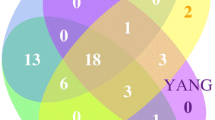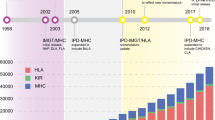Abstract
Several studies have shown that immune system proteins have on average a higher rate of amino acid evolution between different species of mammals than do most other proteins. To test whether immune-system-expressed loci show a correspondingly elevated rate of within-species nonsynonymous (amino acid altering) polymorphism, we examined gene diversity (heterozygosity) at 4,911 single nucleotide polymorphism (SNP) sites at 481 protein-coding loci. At loci with nonimmune functions, gene diversity at nonsynonymous SNP sites was typically lower than that at silent SNP sites (those not altering the amino acid sequence) in the same gene, a pattern that is an evidence of purifying selection acting to eliminate slightly deleterious variants. However, this pattern was not seen at nonsynonymous SNPs causing conservative amino acid replacements in immune system proteins, indicating that the latter are subject to a reduced level of functional constraint. Similarly, immune system genes showed higher gene diversities in their 5′ noncoding regions than did other proteins. These results identified certain immune system loci that are likely to be subject to balancing selection that acts to maintain polymorphism in either coding or regulatory regions.



Similar content being viewed by others
References
Barrett JC, Fry B, Maller J, Daly MJ (2005) Haploview: analysis and visualizationof LD and haplotype maps. Bioinformatics 21:263–265
Freudenberg-Hua Y, Freudenberg J, Kluck N, Cichon S, Propping P, Nöthen MM (2003) Single nucleotide variation analysis in 65 candidate genes for CNS disorders in a representative sample of the European population. Genome Res 13:2271–2276
Hughes AL (1997) Rapid evolution of immunoglobulin superfamily domains expressed in immune system cells. Mol Biol Evol 14:1–5
Hughes AL (1999a) Evolutionary diversification of the mammalian defensins. Cell Mol Life Sci 56:94–103
Hughes AL (1999b) Adaptive evolution of genes and genomes. Oxford University Press, New York
Hughes AL (2002) Evolution of the human killer cell inhibitory receptor family. Mol Phylogenet Evol 25:330–340
Hughes AL, Nei M (1988) Pattern of nucleotide substitution at MHC class I loci reveals overdominant selection. Nature 335:167–170
Hughes AL, Nei M (1989) Nucleotide substitution at major histocompatibility complex class II loci: evidence for overdominant selection. Proc Natl Acad Sci U S A 86:958–962
Hughes AL, Yeager M (1998) Natural selection at major histocompatibility complex loci of vertebrates. Annu Rev Genet 32:415–435
Hughes AL, Packer B, Welch R, Bergen AW, Chanock SJ, Yeager M (2003) Widespread purifying selection at polymorphic sites in human protein-coding loci. Proc Natl Acad Sci U S A 100:15754–15757
Hughes AL, Packer B, Welch R, Bergen AW, Chanock SJ, Yeager M (2005) Effects of natural selection on inter-population divergence at polymorphic sites in human protein-coding loci. Genetics (in press)
Miyata T, Miyazawa S, Yasunaga T (1979) Two types of amino acid substitution in protein evolution. J Mol Evol 12:219–236
Murphy PM (1993) Molecular mimicry and the generation of host defense protein diversity. Cell 72:823–826
Nei M (1987) Molecular evolutionary genetics. Columbia University Press, New York
Packer B, Yeager M, Staats B, Welch R, Crenshaw A, Kiley M, Eckert A, Beerman M, Miller E, Bergen A, Rothman N, Strausberg R, Chanock SJ (2004) SNP500Cancer: a public resource for sequence validation and assay development for genetic variation in candidate genes. Nucleic Acids Res 32:D528–D532
Sherry ST, Warc M-H, Kholodov M, Baler J, Smigielski EM, Sirotkin K (2001) dbSNP: the NCBI database of genetic variation. Nucleic Acids Res 29:308–311
Smith AJP, Keen LJ, Bilingham MJ, Perry MJ, Elson CJ, Kirwan JR, Sims JE, Doherty M, Spector TD, Bidwell JL (2004) Extended haplotypes and linkage disequilibrium in the IL1R1–IL1A–IL1B–IL1RN gene cluster: association with knee osteoarthritis. Genes Immun 5:451–460
Stephens M, Smith NJ, Donnelly P (2001) A new statistical method for haplotype reconstruction from population data. Am J Hum Genet 68:978–989
Sunyaev S, Kondrashov FA, Bork P, Ramensky V (2003) Impact of selection, mutation rate and genetic drift on human genetic variation. Hum Mol Genet 15:3325–3330
Tanaka T, Nei M (1989) Positive Darwinian selection observed at the variable-region genes of immunoglobulin. Mol Biol Evol 6:447–459
Zhao Z, Fu Y-X, Hewett-Emmett D, Boerwinkle E (2003) Investigating single nucleotide polymorphism (SNP) density in the human genome and its implications for molecular evolution. Gene 312:207–213
Acknowledgements
This project has been funded in part with federal funds from the National Cancer Institute, National Institutes of Health, under contract no. NO1-CO-12400. Partial support was provided by N.I.H. grant GM43940 to A.L.H.
Author information
Authors and Affiliations
Corresponding author
Electronic supplementary materials
Rights and permissions
About this article
Cite this article
Hughes, A.L., Packer, B., Welch, R. et al. High level of functional polymorphism indicates a unique role of natural selection at human immune system loci. Immunogenetics 57, 821–827 (2005). https://doi.org/10.1007/s00251-005-0052-7
Received:
Accepted:
Published:
Issue Date:
DOI: https://doi.org/10.1007/s00251-005-0052-7




